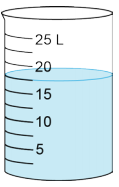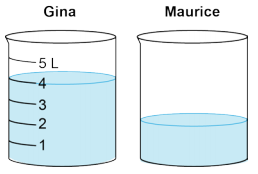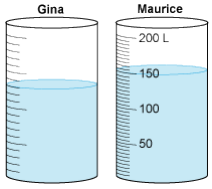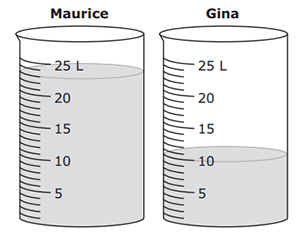General Information
Clusters should not be sorted from Major to Supporting and then taught in that order. To do so would strip the coherence of the mathematical ideas and miss the opportunity to enhance the major work of the grade with the supporting clusters.
Test Item Specifications
Items may not contain compound units such as cubic centimeters (cm3) or finding the geometric volume of a container. Items may not require multiplicative comparison (e.g., “times as much/many”). Unit conversions are not allowed. Units are not limited to grams, kilograms, and liters.
No
Allowable
Sample Test Items (4)
| Test Item # | Question | Difficulty | Type |
| Sample Item 1 | How many liters (L) of water are in the following container?
|
N/A | EE: Equation Editor |
| Sample Item 2 | Gina and Maurice have same-sized containers filled with different amounts of water, as shown.
Gina's container has 4 Liters (L) of water. About how much water, in liters (L), does Maurice's container have? |
N/A | EE: Equation Editor |
| Sample Item 3 | Gina and Maurice have the containers shown.
Gina does not know how much water is in her container. Maurice's container is the same size as Gina's container. About how much less water, in liters (L), does Gina have than Maurice? |
N/A | EE: Equation Editor |
| Sample Item 4 | Maurice and Gina each have a container of water, as shown.
What is the difference, in liters (L), between the amounts of water in their containers? |
N/A | EE: Equation Editor |
Related Courses
| Course Number1111 | Course Title222 |
| 5012050: | Grade Three Mathematics (Specifically in versions: 2014 - 2015, 2015 - 2022, 2022 - 2024, 2024 and beyond (current)) |
| 5020040: | Science - Grade Three (Specifically in versions: 2014 - 2015, 2015 - 2022, 2022 - 2024, 2024 and beyond (current)) |
| 7712040: | Access Mathematics Grade 3 (Specifically in versions: 2014 - 2015, 2015 - 2018, 2018 - 2022, 2022 and beyond (current)) |
| 7720040: | Access Science Grade 3 (Specifically in versions: 2014 - 2015, 2015 - 2018, 2018 - 2023, 2023 and beyond (current)) |
| 5020100: | STEM Lab Grade 3 (Specifically in versions: 2016 - 2022, 2022 - 2024, 2024 and beyond (current)) |
| 5012055: | Grade 3 Accelerated Mathematics (Specifically in versions: 2019 - 2022, 2022 - 2024, 2024 and beyond (current)) |
| 5012015: | Foundational Skills in Mathematics 3-5 (Specifically in versions: 2019 - 2022, 2022 - 2024, 2024 and beyond (current)) |
Related Resources
Assessment
| Name | Description |
| Grade 3 Physical Science Unit: Properties Assessment | Use this summative assessment to assess the students' understanding of the topics presented in within this Grade 3 Physical Science Unit: Properties. The assessment can either be cumulative or broken into topics presented within the unit. This assessment is part of the CPALMS Grade 3 Physical Science Unit on Properties. This is a themed unit of SaM-1's adventures at the CPALMS Rehabilitation and Conservation Center. To see all the lessons in the unit please visit https://www.cpalms.org/page818.aspx . |
Educational Game
| Name | Description |
| Estimation of Length, Area, and Volume | The students will be presented with two shapes and must estimate how many times the smaller will fit in the larger. They will be surprised at some of the results but will quickly learn and make adjustments. |
Formative Assessments
| Name | Description |
| Estimating and Measuring Mass | Students are asked to estimate the mass (in grams) of a stapler and then are asked to determine its actual mass using a scale or balance. |
| Addition and Subtraction with Mass and Volume | Students solve two one-step word problems about mass and volume. |
| Estimating and Measuring Volume | Students are asked to estimate the volume (in liters) of a container and then are asked to determine its actual volume using beakers. |
| Multiplication and Division with Mass and Volume | Students solve two one-step word problems about mass and volume. |
Lesson Plans
| Name | Description |
| Physical Science Unit: Water Beach Vacation Lesson 1 Observations | Students learn that making observations is an important aspect of scientific study. Students will review concepts about water by making observations based on different properties and states of matter of water. Students will also review how to measure volume, mass and temperature as they will use these skills throughout the unit. This is a lesson in the Grade 3 Physical Science Unit on Water. This is a themed unit of SaM-1's adventures while on a Beach Vacation. To see all the lessons in the unit please visit https://www.cpalms.org/page818.aspx. |
| Physical Science Unit: Water Beach Vacation Lesson 12 Engineering Design Problem: Beat the Heat Part 3: Testing a Cooler | In this engineering design problem, students will have the opportunity to apply what they This is a lesson in the Grade 3 Physical Science Unit on Water. This is a themed unit of SaM-1's adventures while on a Beach Vacation. To see all the lessons in the unit please visit https://www.cpalms.org/page818.aspx.
|
| Physical Science Unit: Water Beach Vacation Lesson 5 Evaporation Experiment | Students set up an experiment and gather data to investigate the evaporation of water. This is a lesson in the Grade 3 Physical Science Unit on Water. This is a themed unit ofSaM-1's adventures while on a Beach Vacation. To see all the lessons in the unit please visit https://www.cpalms.org/page818.aspx. . |
| Physical Science Unit: Water Beach Vacation Lesson 4 Melting Experiment | Students set up an experiment and gather data to investigate the melting of solid water. This is a lesson in the Grade 3 Physical Science Unit on Water. This is a themed unit ofSaM-1's adventures while on a Beach Vacation. To see all the lessons in the unit please visit https://www.cpalms.org/page818.aspx. . |
| Physical Science Unit: Properties Lesson 10 Grouping by Mass | Students will make objects of given masses based on identified animal needs using a balance. This lesson could also be taught using mathematics instructional time. This is a lesson in the Grade 3 Physical Science Unit on Properties. This is a themed unit of SaM-1's adventures at the CPALMS Rehabilitation and Conservation Center. To see all the lessons in the unit please visit https://www.cpalms.org/page818.aspx . |
| Physical Science Unit: Properties Lesson 14 Volume: Solids Displacement | Students will make learn how to find the volume of irregular objects using a graduated cylinder. Students will solve problems based on the volume of irregular objects and determine the volumes of given objects. This lesson could also be taught using mathematics instructional time. This is a lesson in the Grade 3 Physical Science Unit on Properties. This is a themed unit of SaM-1's adventures at the CPALMS Rehabilitation and Conservation Center. To see all the lessons in the unit please visit https://www.cpalms.org/page818.aspx . |
| Physical Science Unit: Properties Lesson 13 Introduction to Displacement | Students will make learn how to find the volume of irregular objects using a graduated cylinder. Students will solve problems based on the volume of irregular objects and determine the volumes of given objects. This lesson could also be taught using mathematics instructional time. This is a lesson in the Grade 3 Physical Science Unit on Properties. This is a themed unit of SaM-1's adventures at the CPALMS Rehabilitation and Conservation Center. To see all the lessons in the unit please visit https://www.cpalms.org/page818.aspx . |
| Physical Science Unit: Properties Lesson 12 Volume: Liquids | Students will learn how to use a graduated cylinder to make observations based on the volume of liquids. Students will solve word problems based on volume and measure out given liquid volumes. This lesson could also be taught using mathematics instructional time. This is a lesson in the Grade 3 Physical Science Unit on Properties. This is a themed unit of SaM-1's adventures at the CPALMS Rehabilitation and Conservation Center. To see all the lessons in the unit please visit https://www.cpalms.org/page818.aspx . |
| Physical Science Unit: Properties Lesson 11 Introduction to Volume | Students will learn how to use a graduated cylinder to make observations based on the volume of liquids. This lesson could also be taught using mathematics instructional time. This is a lesson in the Grade 3 Physical Science Unit on Properties. This is a themed unit of SaM-1's adventures at the CPALMS Rehabilitation and Conservation Center. To see all the lessons in the unit please visit https://www.cpalms.org/page818.aspx .
|
| Physical Science Unit: Properties Lesson 7 Measuring Mass | Students will make observations and sort items based on the mass of materials using a balance. This lesson could also be taught using mathematics instructional time. This is a lesson in the Grade 3 Physical Science Unit on Properties. This is a themed unit of SaM-1's adventures at the CPALMS Rehabilitation and Conservation Center. To see all the lessons in the unit please visit https://www.cpalms.org/page818.aspx. |
| Physical Science Unit: Properties Lesson 8 Mass Solids | Students will make observations and sort items based on the mass of materials using a balance. This lesson could also be taught using mathematics instructional time. This is a lesson in the Grade 3 Physical Science Unit on Properties. This is a themed unit of SaM-1's adventures at the CPALMS Rehabilitation and Conservation Center. To see all the lessons in the unit please visit https://www.cpalms.org/page818.aspx . |
| Physical Science Unit: Properties Lesson 9 Mass: Liquids | Students will make observations and sort liquid items based on the mass of materials using a balance. This lesson could also be taught using mathematics instructional time. This is a lesson in the Grade 3 Physical Science Unit on Properties. This is a themed unit of SaM-1's adventures at the CPALMS Rehabilitation and Conservation Center. To see all the lessons in the unit please visit https://www.cpalms.org/page818.aspx .
|
| Max Mass Movers | In this design challenge, students will explore the measurement of mass and properties of matter as they design a container that can hold the most mass. |
| What's the Matter with a Crayon? | In this lesson, students will cooperatively measure the mass and volume of three different-colored crayons as a solid. After recording measurements, students will place their crayons in molds in order to change the state of matter from a solid to a liquid through heating. The teacher will pour the liquefied crayon into a graduated cylinder to measure the volume. Following the measurements recording, the liquid will be poured back into the molds and placed in a cool/shaded environment so the crayons will change back into a solid state. Once the crayons re-solidify, the students will take their student-made, tie-dye crayon out of the mold and re-measure it. Lastly, the students will measure and compare their final measurements to the initial measurements. |
| Let's Go, H2O! | This STEM challenge will engage 3rd grade students in thinking about the ways that a drought can affect a region or nation and how to find a solution to this problem. Students will construct a pipeline to transport water from point A to point B while overcoming gravity and will measure the volume of liquid before and after it travels through the pipeline. This STEM challenge combines architectural engineering with life science and mathematical measurement skills. |
| Is that Estimate Correct? | In this lesson, students will estimate water volume in three containers and record observations. Following estimations, students will directly measure the volumes using an appropriate method. After comparing those measurements to the estimates, students will be given a known volume of water and will be asked to divide the water into three predetermined volumes, again using estimation skills. A following measurement will be used to determine the difference between their volume estimate and the actual measured volume as distributed across three vessels. |
| Kick The Can Man | Students are asked to compare group observations, measure and estimate content of liquids, and prepare and participate in a range of conversations in order to design a method for choosing the healthiest beverage to supply to school children. Model Eliciting Activities, MEAs, are open-ended, interdisciplinary problem-solving activities that are meant to reveal students’ thinking about the concepts embedded in realistic situations. Click here to learn more about MEAs and how they can transform your classroom. |
Model Eliciting Activity (MEA) STEM Lessons
| Name | Description |
| Physical Science Unit: Water Beach Vacation Lesson 15 Beat the Heat MEA Part 2: Cooler Experiment | In this MEA, students will have the opportunity to apply what they learned about describing This is a lesson in the Grade 3 Physical Science Unit on Water. This is a themed unit of SaM-1's adventures while on a Beach Vacation. To see all the lessons in the unit please visit https://www.cpalms.org/page818.aspx. |
| Physical Science Unit: Water Beach Vacation Lesson 16 Beat the Heat MEA Part 3: Analyzing Cooler Data | In this MEA, students will have the opportunity to apply what they learned about describing This is a lesson in the Grade 3 Physical Science Unit on Water. This is a themed unit of SaM-1's adventures while on a Beach Vacation. To see all the lessons in the unit please visit https://www.cpalms.org/page818.aspx. |
| Physical Science Unit: Water Beach Vacation Lesson 17 Beat the Heat MEA Part 4: Ranking Procedure | In this MEA, students will have the opportunity to apply what they learned about describing This is a lesson in the Grade 3 Physical Science Unit on Water. This is a themed unit of SaM-1's adventures while on a Beach Vacation. To see all the lessons in the unit please visit https://www.cpalms.org/page818.aspx. |
| Physical Science Unit: Water Beach Vacation Lesson 9 Cool Cooler Design Model-Eliciting Activity (MEA) | In this MEA, students will have the opportunity to apply what they learned about describing This is a lesson in the Grade 3 Physical Science Unit on Water. This is a themed unit ofSaM-1's adventures while on a Beach Vacation. To see all the lessons in the unit please visit https://www.cpalms.org/page818.aspx.
|
Original Student Tutorials
| Name | Description |
| Lessons 8 and 9 Video: Mass: Solids and Liquids | In this SaM-1 video, students will learn how to measure the mass of solids and liquids using a balance. Students will learn that they need to subtract the mass of the container the solid or liquid is in to determine the mass of only the solid or liquid. Students will then make observations and sort items based on mass. |
| Physical Science Unit: Water Beach Vacation Lesson 17 Video | This SaM-1 video provides the students with the optional "twist" for Lesson 17 and the Model Eliciting Activity (MEA) they have been working on in the Grade 3 Physical Science Unit: Water Beach Vacation.
To see all the lessons in the unit please visit https://www.cpalms.org/page818.aspx. |
| Lesson 13 Video: Introduction to Displacement | In this SaM-1 Video, students will learn how to find the volume of irregular objects using a graduated cylinder and the displacement method. |
| Lesson 11 Video: Introduction to Volume | In this SaM-1 video, students will learn how to use a graduated cylinder to make observations based on the volume of liquids. |
| Lesson 7 Video: Measuring Mass | Help SaM-1 make observations and sort items based on the mass of materials using a triple-beam balance and equal-arm balance. In this video, you will also become familiar with metric units for measuring mass: gram and kilogram. |
| Timmy's Trouble with Taffy | Learn to estimate and measure the masses of objects in grams and kilograms in this interactive tutorial with an animal hospital theme. |
Professional Development
| Name | Description |
| What Does It Mean To Measure? | This is a professional development session from the Learning Math series from Annenberg. Learners will begin to explore the questions "What can be measured?" and "What does it mean to measure something?" Learners identify measurable properties of objects such as weight, surface area, and volume, and discuss which metric units are appropriate for measuring these properties. Learners will also learn that measurement is, by its nature, approximate. Finally, learners will consider how to make measurements using nonstandard units. This session features a number of problems for learners to solve and open-ended questions to discuss, videos that demonstrate measurement techniques, and an interactive activity that asks learners to construct shapes using different size triangles to foster understanding of area and perimeter. There are also nine homework problems in which learners are asked to generate different measurements, graph measurements, and evaluate the appropriateness of the measurements generated using a data chart. Many of the professional development activities can be used directly in the classroom. |
Teaching Idea
| Name | Description |
| Weighing In | "Grocery shopping offers opportunities for children to increase their estimation and measurement skills by choosing and weighing fruit and vegetables" (from ed.gov parent resources). Kids are estimating the weight of different items and confirm their estimates by weighing afterward. Kids are encouraged to use different units of measurement and compare the number of heavier / lighter items necessary for a certain weight. This is one of seven in a series of activities for practicing math skills at the grocery store. |
Tutorial
| Name | Description |
| Liter intuition | In this tutorial video from Khan Academy, explore questions such as: What is the volume of a jar of milk? How about a spoon? A swimming pool? |
Student Resources
Original Student Tutorials
| Name | Description |
| Lessons 8 and 9 Video: Mass: Solids and Liquids: | In this SaM-1 video, students will learn how to measure the mass of solids and liquids using a balance. Students will learn that they need to subtract the mass of the container the solid or liquid is in to determine the mass of only the solid or liquid. Students will then make observations and sort items based on mass. |
| Physical Science Unit: Water Beach Vacation Lesson 17 Video: | This SaM-1 video provides the students with the optional "twist" for Lesson 17 and the Model Eliciting Activity (MEA) they have been working on in the Grade 3 Physical Science Unit: Water Beach Vacation.
To see all the lessons in the unit please visit https://www.cpalms.org/page818.aspx. |
| Lesson 13 Video: Introduction to Displacement : | In this SaM-1 Video, students will learn how to find the volume of irregular objects using a graduated cylinder and the displacement method. |
| Lesson 11 Video: Introduction to Volume: | In this SaM-1 video, students will learn how to use a graduated cylinder to make observations based on the volume of liquids. |
| Lesson 7 Video: Measuring Mass: | Help SaM-1 make observations and sort items based on the mass of materials using a triple-beam balance and equal-arm balance. In this video, you will also become familiar with metric units for measuring mass: gram and kilogram. |
| Timmy's Trouble with Taffy: | Learn to estimate and measure the masses of objects in grams and kilograms in this interactive tutorial with an animal hospital theme. |
Educational Game
| Name | Description |
| Estimation of Length, Area, and Volume: | The students will be presented with two shapes and must estimate how many times the smaller will fit in the larger. They will be surprised at some of the results but will quickly learn and make adjustments. |
Tutorial
| Name | Description |
| Liter intuition: | In this tutorial video from Khan Academy, explore questions such as: What is the volume of a jar of milk? How about a spoon? A swimming pool? |
Parent Resources
Teaching Idea
| Name | Description |
| Weighing In: | "Grocery shopping offers opportunities for children to increase their estimation and measurement skills by choosing and weighing fruit and vegetables" (from ed.gov parent resources). Kids are estimating the weight of different items and confirm their estimates by weighing afterward. Kids are encouraged to use different units of measurement and compare the number of heavier / lighter items necessary for a certain weight. This is one of seven in a series of activities for practicing math skills at the grocery store. |
Tutorial
| Name | Description |
| Liter intuition: | In this tutorial video from Khan Academy, explore questions such as: What is the volume of a jar of milk? How about a spoon? A swimming pool? |




